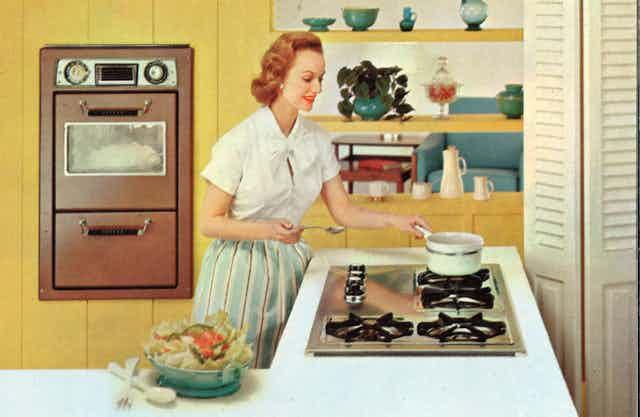Alena Petitt, a well-known author and lifestyle blogger, has become the British face of the “Tradwife” movement, closely associated with the hashtag #TradWife. The movement harks back to an earlier era, encouraging women to take pleasure in traditional domestic duties while promoting feminine submissiveness, domesticity, and wifehood.
In a BBC clip, Petitt explains that her role is to submit to, serve, and spoil her husband “like it’s 1959”.
Writing on her website, The Darling Academy, she adds that many women crave a “sense of belonging and home and quaintness,” and therefore choose to become homemakers where “husbands must always come first”.
Given its glorification of traditional femininity, the Tradwife movement is often framed in the media as a backlash against feminism. This can been seen in news stories featuring bitter disagreements between feminist critics and women who embrace a tradwife identity.
A choice as much as any
This emphasis on “tradwives vs feminists” is sadly predictable. It fits the all-too-familiar trope of “catfighting” so often characterising conversations about feminist politics in the media. This framing, wittingly or unwittingly, identifies feminism as the problem, ignoring the larger structural issues at stake.
Rather than simply a backlash against feminism, the tradwife phenomenon needs to be understood as a symptom of – as well as a reaction to – the increasing insecurity of our times.
Tradwives often use the language of choice. They describe their decision to step off the treadmill of work as a “true calling” to be homemakers, mothers and wives. But even the most private of choices – like deciding to leave a career and become a full-time housewife – are always made within structural constraints. As one of us (Shani) shows in the book Heading Home, these choices are always shaped by social, cultural, economic and political conditions.
Many of the women in tradwife groups discuss the strain of working in demanding jobs and the difficulty of coming home to, what the American writer Arlie Hochschild has famously called, the second shift. This includes tending to children and household chores, as well as looking after elderly family members.
Petitt herself talks about how in her early twenties she was a driven career woman. Another self-identifying tradwife, Jenny Smith (pseudonym), recounts working long days as a finance administrator before dramatically changing course.
The current toxic always-on work culture must be understood as a key factor facilitating the rise of this retro-movement. As overload work culture has become common in many developed countries, governments have also been cutting vital resources that help support families and communities. Combined with entrenched gendered social norms, the burden of care disproportionately falls on women. Even relatively privileged women therefore find it difficult to live up to the popular feminist ideal of “work-life balance”.
So although at first blush the Tradwife movement may seem profoundly at odds with our times – particularly in the wake of movements likes MeToo and TimesUp – it is very much a product of the contemporary moment. The choices made by women who identify as tradwives may be presented as entirely personal. However, they are inseparable from the profound crisis of both work and care under neoliberal capitalism.
Gaining control
We live in a time when normative gender roles and dominant notions of sexuality have not only been challenged but are in flux. As such, reasserting a narrowly defined version of femininity may be a way for some women to gain a sense of control over their lives.
“Being a tradwife is empowering and has enabled me to take back control of my life,” explains Stacey McCall. A 33-year old tradwife, she quit her job due to the pressures of her and her husband both working in demanding full-time jobs.
Unsurprisingly, the movement is aligned with notions of traditional Britishness in the UK, and, as some have suggested, with the alt-right in the US. Despite their nominal differences, however, both movements are united by a similar nostalgia for an imagined harmonious national past, which has a form of gender traditionalism at its heart.
Tradwife blogs and videos are filled with serene settings outside the world of neoliberal capitalist work. Retro 1950s images of women as “happy housewives” abound. Yet paradoxically, this nostalgic return to a simpler and better past is dependent on the very values that it seemingly rejects.
Tradwives like Alena Petitt in the UK and US blogger Dixie Andelin Forsyth have become successful entrepreneurs who monetize their trad-wifehood. The movement, more generally, depends on savvy entrepreneurial women like these, who, through their social media activities, classes, courses, advice books, and products, advocate and popularise trad-wifehood as a desirable choice and identity.
Far from refusing neoliberal capitalism, the world of paid full-time labour or even what some consider feminist success, the Tradwife movement is deeply embedded in and indebted to all of them.

